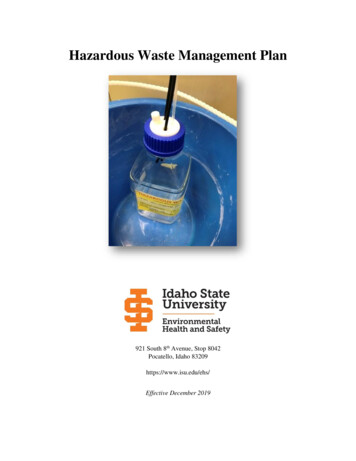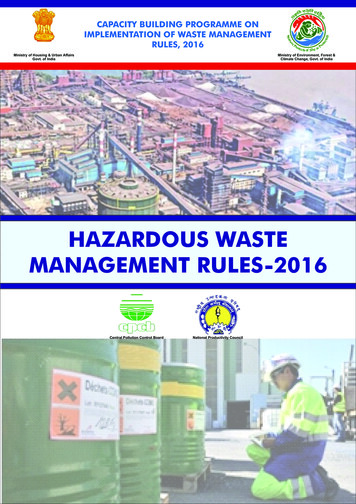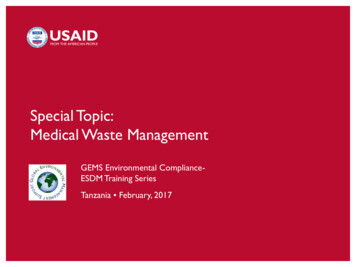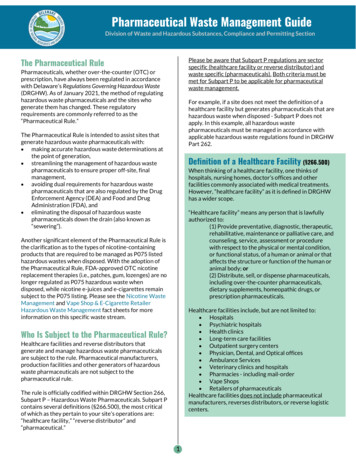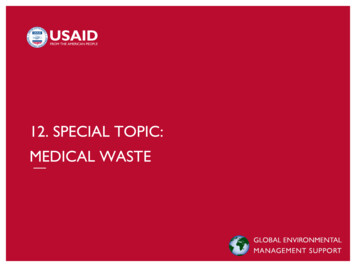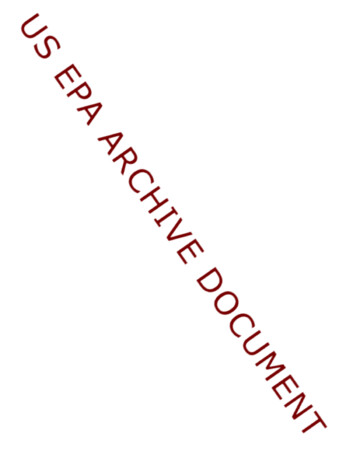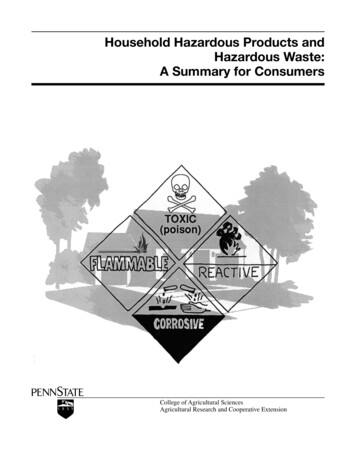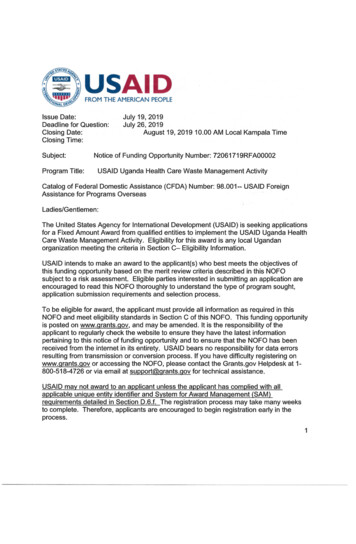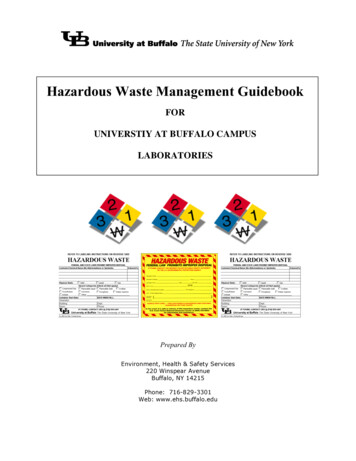
Transcription
Hazardous Waste Management GuidebookFORUNIVERSTIY AT BUFFALO CAMPUSLABORATORIESPrepared ByEnvironment, Health & Safety Services220 Winspear AvenueBuffalo, NY 14215Phone: 716-829-3301Web: www.ehs.buffalo.edu
UB EH&S Hazardous Waste Management GuidebookTableofContents1.0PURPOSE . 32.0SCOPE . 43.0DEFINITIONS . 44.0RESPONSIBILITIES . 54.1 EH&S . 54.2 Faculty, Staff, and Students . 55.0 PROCEDURES . 65.1 Hazardous Waste Determination . 65.1.1Characteristic Hazardous Wastes . 75.1.2Listed Hazardous Wastes . 95.2Satellite Accumulation of Hazardous Waste . 95.2.1Accumulation Areas . 105.2.2Requirements for Hazardous Waste Containers . 105.2.3Segregation of Hazardous Wastes . 115.2.4Pickup for Full Waste Containers . 135.2.5Weekly Inspection of Accumulation Areas . 135.3Other Waste Requirements . 145.3.1Drain Disposal Guidance for Laboratory Wastes . 145.3.2Biohazardous Wastes . 155.3.3Radioactive Wastes . 155.3.4Mixed Wastes (Chemical, Biohazardous, Radioactive). 165.3.5Ethidium Bromide . 175.3.6Photographic and X-ray Fixer Waste . 175.3.7Aerosol Spray Cans . 175.3.8Battery Recycling . 175.3.9Reagents Used in Biological Procedures . 185.3.10 Broken Glass. 185.4Empty Containers . 195.5Waste Minimization . 205.5.1Source Reduction . 205.5.2Recycling . 225.5.3Process Modification . 23Revised 1-27-14Page 1 of 27
UB EH&S Hazardous Waste Management Guidebook5.6Emergency and Spill Response . 235.6.1Chemical Spill Emergency Procedures . 235.6.2General Emergency Procedures . 275.7Training. 27AppendicesAppendix AToxic Hazardous WastesAppendix BTable of EH&S Listed Hazardous WastesAppendix CTable of EH&S Acutely Hazardous WastesAppendix DFormsAttachment 1UB Campus Commitment to SafetyACKNOWLEDGEMENTEH&S wishes to acknowledge those institutions that providedinformation, resources, and references through their websites thatwere incorporated in this document: The State University of New York at Stony BrookUniversity of FloridaUniversity of LouisvilleUniversity of California San DiegoUniversity of KentuckyUniversity of MaineUniversity of MinnesotaUniversity of Illinois at Urbana-ChampaignUniversity of WisconsinDocument Revision HistoryRevision #DateSectionIssued05/09/03Rev 102/12/045.2.25.2.5Rev 1.102/18/045.3.1Rev 2 (layoutreformat)05/20/115.3.25.3.35.3.45.3.8Rev 2.109-10-12-Rev 2.201-27-14-Changes MadeOriginal PublicationChanged “must” to “should” (6th bullet)Changed “must” to “should”Added “Ethanol concentration of 24% or less” under Acceptable for DrainDisposal; Under Do No Drain Dispose , changed 3rd bullet to read “ethanolgreater than 24%, etc.”Updated Biohazardous Wastes sectionUpdated Radioactive Waste sectionUpdated Mixed Radioactive /Chemical Waste sectionAdded Battery Recycling SectionChanged wording so that one manual can be used for all campus locations (i.e.“campus labs/users”, emergency numbers)Incorporated this document into the new EH&S Laboratory Safety Manual.Removed the emergency contact number page from the front of this manualand added revised emergency contact information in callout boxes to section5.6, Emergency and Spill ResponseRevised 1-27-14Page 2 of 27
UB EH&S Hazardous Waste Management leviolationcanresultinuptoa 25,000fine.PURPOSEThe purpose of this guidebook is to provide all UB Campus users withthe following concise and direct information: Hazardous waste requirements by regulatory agenciesHazardous waste determinationHazardous waste accumulation, storage, and pickup proceduresProcedures for empty hazardous material and waste containersWaste minimization proceduresEmergency and spill response proceduresTraining requirementsThe framework for hazardous waste regulation was established in1976 by the Resource Conservation and Recovery Act (RCRA). RCRAwas enacted by Congress to protect human health and theenvironment from improper management of hazardous waste. RCRAintroduced the concept that the generator of a waste is responsiblefor proper waste management from "cradle-to-grave" (i.e., fromlaboratory to complete destruction).RCRA regulations are found in the 40 Code of Federal Regulations(CFR) Parts 260-279 and can be accessed at the United StatesEnvironmental Protection Agency (USEPA) website (www.epa.gov).There are specific regulatory requirements for individuals whogenerate and accumulate chemical waste that cover training,proper waste identification, labeling, containment, and disposal, andwaste minimization and recycling.An overview of the UB hazardous waste management procedures ispresented in this document. The procedures outlined in thisdocument are designed to promote: Safe handling of wastes to prevent spills and other accidentsAn efficient disposal process for all employees at UBCompliance with all applicable regulations governing hazardouswastesImplementation of these procedures requires the cooperation offaculty, staff, and (EH&S)at829- ‐3301.Revised 1-27-14Page 3 of 27
UB EH&S Hazardous Waste Management Guidebook2.0SCOPEThe scope of this document covers the hazardous wastemanagement, training, and disposal requirements specified by theUSEPA and NYSDEC for laboratory personnel. Specifically, thisdocument is designed to comply with the regulations given in 40 CFR260-272 by the USEPA and 6 NYCRR Part 373 by NYSDEC for satelliteaccumulation areas managed by employees of the University atBuffalo.3.0DEFINITIONSDefinitions and abbreviations used in this Guidebook:CFR: Code of Federal RegulationsGenerator: Per 40 CFR 260.10, “Any person, by site, whose act orprocess produces hazardous waste identified or listed in Part 261 orwhose act first causes a hazardous waste to become subject toregulation.”HazMat: Hazardous materialsNYCRR: New York Code of Rules and RegulationsNYSDEC: New York State Department of Environmental ConservationEH&S: Environment, Health & Safety ServicesPerson: (40 CFR 260.10) RCRA defines a “person” very broadly tomean an individual, trust, firm, joint stock company, Federal Agency,corporation, partnership, association, State, municipality, commission,political subdivision of a State, or any interstate body. For theUniversity, a “person” would be a Principal Investigator or Supervisor,or Lab Worker.RCRA: Resource Conservation and Recovery ActRMW: Regulated Medical WasteTCLP: Toxic Characteristic Leaching ProcedureUB: University at Buffalo, The State University of New YorkUniversity: UBUSEPA: United States Environmental Protection AgencyRevised 1-27-14Page 4 of 27
UB EH&S Hazardous Waste Management Guidebook4.0RESPONSIBILITIES4.1 EH&SEH&S functions both in an advisory and consultative capacity, and asa service organization for the hazardous waste managementprogram at the University at Buffalo. Specific functions are as follows:1.2.3.4.5.6.7.8.Coordinate the comprehensive hazardous waste managementprogramEnsure all hazardous waste permits are obtained and maintainedcurrentOperate a campus-wide hazardous waste collection servicewhich provides for the safe and timely collection/removal ofhazardous materialsManage applicable disposal service contractsPrepare and submit regulatory reports, regulatory fees andhazardous waste taxesProvide training to individuals who handle hazardous wastes orinspect accumulation areasCoordinate the waste minimization programAssist academic personnel (customers) with compliancequestions and problems to continuously improve campuscompliance4.2 Faculty, Staff, and StudentsFaculty, staff, and students have the following responsibilities:1.2.Faculty, staff, and students are responsible for complying withthe regulations and practices promulgated as a result of federaland state legislation, University policy and/or establishedguidelines.Faculty and staff are responsible for ensuring employees andstudents are aware of and properly implementing safe handlingand storage procedures for hazardous materials and wastes.Revised 1-27-14Page 5 of 27
UB EH&S Hazardous Waste Management Guidebook5.0 PROCEDURESDisposal of hazardous waste using sinks, intentional evaporation, andgeneral trashcans is prohibited by law. UB laboratory personnel mustabide by strict state and federal waste disposal requirements. Use thefollowing information to make sure you have identified all hazardouswaste you generate and dispose of it properly.5.1 Hazardous Waste DeterminationUSEPA- nitiono ouractivitiesareregulatedbylaw.USEPA explicitly describes the requirements:1.You must determine if you are a generator of hazardous waste.USEPA defines a generator in 40 CFR 260.10 as, “Any person, bysite, whose act or process produces hazardous waste identifiedor listed in Part 261 or whose act first causes a hazardous wasteto become subject to regulation.”The first thing you need to know is “Who is a Generator?” Withinthe definition presented here, there are several “key words” thatneed some explanation: Person - (40 CFR 260.10) RCRA defines a “person” very broadlyto mean an individual, trust, firm, joint stock company, federalagency, corporation, partnership, association, state,municipality, commission, political subdivision of a state, orany interstate body. For the University, a “person” would be aPrincipal Investigator or Supervisor or lab worker. Site - while “site” is not specifically defined, the definition ofthe term “on-site” (40 CFR 260.10) talks about the same orgeographically contiguous property. The point here is thateach individual location owned by a “person” is a separatesite, and thus a separate generator. For the University, eachcampus, and everything “inside its respective fence” is a site. Produces a Waste - as it implies, those whose act orprocess/produce a waste are generators of the waste. At theUniversity the “person” that would produce the waste wouldbe the respective Principal Investigator, supervisor, lab worker,or lab student that generates the waste.Revised 1-27-14Page 6 of 27
UB EH&S Hazardous Waste Management GuidebookABANDONED CHEMICALS2.Many laboratory wastegenerators accumulate orstore chemicals which havevalue, but over time become“forgotten.”A generator must determine if the waste is a solid waste.According to the USEPA, a solid waste DOES not have to be“solid!” A “solid” waste can be either solid, liquid, or acompressed gas and is specifically defined as:Any discarded material that is:oooo3.Abandoned through (1) disposal, (2) burning orincineration, or (3) accumulation, storage, or treatment; orRecycled; orInherently waste-like (dioxins & furans)And is not excludedIf it is a solid waste, a generator must determine if the waste is ahazardous waste.All wastes generated at the University must be characterized todetermine whether they are a hazardous waste. Once you havea waste, it can be defined as a Hazardous Waste by twodifferent means, “Characteristic” or “Listed” as described in thenext section.5.1.1When the PrincipalInvestigator or Supervisor failsto manage and maintain theirchemicals (containerscorrode, labels fall off, labelsyellow with age, etc.), thechemicals, by USEPAdefinition, become“abandoned.” Anabandoned material isconsidered DISCARDED, and istherefore a SOLID WASTE.MANAGE OR DISPOSE OFABANDONED CHEMICALSIMMEDIATELYCharacteristic Hazardous WastesA waste is hazardous if it exhibits any one of the four characteristics ofa hazardous waste: Ignitability, Corrosivity, Reactivity, or Toxicity. Mostwastes generated in laboratories will be hazardous due to one ofthese characteristics. If there is doubt as to whether your waste meetsone of the four characteristics, EH&S requires it to be handled as ahazardous waste.The following are a few examples of common wastes at theUniversity:IgnitableooooFlammable liquids - flashpoint 140ºF - Alcohols, Benzene,Toluene, Xylene, AcetonitrileOxidizers - Nitrates, Perchlorates, Bromates,Permanganates, Peroxides, IodatesOrganic peroxides - Benzoyl Peroxide, CumeneHydroperoxide, Methyl Ethyl Ketone PeroxideFlammable compressed gases – Butane, Acetylene,AmmoniaRevised 1-27-14Page 7 of 27
UB EH&S Hazardous Waste Management GuidebookCorrosive - Aqueous liquids with pH 2 or pH 12.5 or other liquidscapable of corroding steel at a rate of 6.35 mm (0.250 inches)/yearat a test temperature of 55º C (using an ASTM test wastedetermination.Assumethatallchemicalw ineat829- ‐3301.Inorganic acids - Hydrochloric Acid, Sulfuric Acid, NitricAcid, Perchloric Acid, Phosphoric AcidOrganic acids - Formic Acid, Lactic AcidBases - Hydroxide Solutions, AminesReactive - Materials which are normally unstable and readily undergoviolent change, react violently with water, form potentially explosivemixtures with water, form toxic gases, vapors, or fumes when mixedwith water, capable of detonation or explosive decomposition ifsubjected to a strong initiating source or heated under confinement,or capable of detonation or reaction at standard temperature andpressureoooooooSulfides and cyanidesPeroxide formers - Ethers, Potassium Amide, SodiumAmide, Vinyl Acetate, TetrahydrofuranAlkali metals - Sodium, Potassium, LithiumDinitro - and trinitro - compounds - Picric AcidCarbonyl compoundsIsocyanatesPerchlorate crystal formers - Perchloric AcidToxic - A USEPA specified select group of eight (8) heavy metals, ten(10) pesticides, and twenty-two (22) organic chemicals are classifiedas hazardous due to their toxicity characteristics (Appendix A). Anydetectable amount of these chemicals must be identified on theHazardous Waste label (Section 5.2).In addition, wastes that exhibit the following toxicity are consideredhazardous wastes:oooooAn acute oral LD50 less than 5,000 mg/kgAn acute dermal LD50 less than 4,300 mg/kgAn acute inhalation LC50 less than 10,000 ppm as a gas orvaporAn acute aquatic 96-hour LC50 less than 500 mg/lWastes that pose a hazard to human health orenvironment because of its carcinogenicity (carcinogen,mutagen, teratogen), acute toxicity, chronic toxicity,bioaccumulative properties, or persistence in theenvironmentRevised 1-27-14Page 8 of 27
UB EH&S Hazardous Waste Management edetermination.Assumethatallchemicalw tions,contactEH&Sforassistanceat829- ‐3301.5.1.2Listed Hazardous WastesThe USEPA has promulgated a list of chemicals found in 40 CFR 260279 that are automatically determined to be a hazardous waste. Ifyour waste chemical is on the list, it is a hazardous waste. There areover 2000 chemicals found on this list (Appendix B). CHECK THIS LISTFOR YOUR WASTE MATERIAL. If it's on this list, treat it as a hazardouschemical waste. If you don't see your material on this list, determine ifit meets any of the characteristics listed in Section 5.1.1, above. If yourwaste meets any of those characteristics, it is a hazardous chemicalwaste and must be handled according the instructions given in thisguidebook (Section 5.2).Acute Hazardous WastesSome of the wastes listed in Appendix B are on a sub-list of what theUSEPA calls “acutely hazardous wastes” (also called “P-listed” wastesbecause their USEPA waste numbers all start with a “P” for “poison”).The acutely hazardous wastes are specifically identified in AppendixC by name. Wastes containing these chemicals are limited to onetotal quart per accumulation area [your laboratory] (Section ralizedstorageo sinaccordancew ithUSEPAregulations.5.2Satellite Accumulation of Hazardous WasteEight Golden Rules of Hazardous Chemical Waste Accumulation:1.2.3.4.5.6.7.8.Put the “Hazardous Waste” label on the container as soon ashazardous waste is first addedKeep the waste container closed, except when adding wasteStore all liquid containers in secondary containmentSegregate containers, keeping incompatible wastes, radioactivewastes, and regulated medical wastes separateInspect waste accumulation areas weeklyIf you accumulate more than 55 gallons of hazardous waste or 1pound of acutely hazardous waste in a satellite accumulationarea , all waste MUST BE REMOVED from accumulation areawithin 3 DAYSFor chemical hazardous waste, complete the chemical wastePickup Request Form and fax to EH&S. Forms are available atthe EH&S website (ehs.buffalo.edu)For regulated medical waste pickup, check with your individualdepartment or call UB Procurement Services at 645-2676 for thelatest approved contractorRevised 1-27-14Page 9 of 27
UB EH&S Hazardous Waste Management GuidebookHazardous Waste Label:Label container as soonas waste is first added5.2.1Accumulation AreasGenerators may accumulate up to a total of 55 gallons of hazardouswaste, or a total of one (1) quart of acutely hazardous waste, at ornear the point of generation [your laboratory], provided that thewaste:oooDO NOT use chemicalsymbols, abbreviations,and/or formulas as ameans of identification5.2.2Remains under the control of the Principal Investigator orSupervisor and their assistantsContainers are closed and in good conditionContents are marked on the outside of the containerRequirements for Hazardous Waste Containers1.Hazardous waste containers must be labeled with a hazardouswaste label as soon as waste is first added2.Follow instructions on the back of the label to fill out. Label mustbe completely filled out, EXCEPT FOR THE “DATE WHEN FULL”è SoDO NOT leave wastecontainers open!oo3.Hazardous waste containers must be compatible with theircontents (Section 5.2.3)ooo4.BY LAW, chemical symbols, abbreviations, and/or formulasare not permitted as a means of identificationDo not omit the cation or anion name for aqueoussolutions of saltsDo not use “Exp. # .” as a means of identificationDo not store corrosive wastes in metal containersDo not store waste hydrofluoric acid in glass containersDo not store waste organic solvents in plastic containersHazardous waste containers must be kept closed, except whenwaste is added. Use a container with a flat bottom. Mostcommon problems found with containers:oooThe funnel is left in open containerAn open container is left in fume hoodDO NOT USE stoppers or corks! Use a screw-top lid5.Hazardous waste containers must be leak-proof and free ofexterior contamination6.Wipe down containers prior to requesting pickup by EH&S(Section 5.2.4)Revised 1-27-14Page 10 of 27
UB EH&S Hazardous Waste Management Guidebook7.Hazardous waste containers should be in secondarycontainmentooooSecondarycontainment can beany container ortray that will hold110% of the volumeof the largest wastecontainer storedwithin the secondarycontainment, andshould beExample of Secondarycompatible with theContainment - Note properlylabeled containerhazardous wasteSecondarycontainment will hold any waste chemical spills or leaksfrom the waste containers within itSecondary containment also is used to segregatehazardous wastes that are incompatible, such as wasteacids and basesLab trays and dishpans are frequently used for secondarycontainment in laboratories5.2.3Segregation of Hazardous Wastes1.Chemical hazardous wastes must be segregated (storedseparately) from incompatible chemical wastes, radioactivewastes, and regulated medical wastesChemical wastes should be accumulated and segregated bythe following general groupings:2.ooMineral (Inorganic) Acids - Examples: hydrochloric acid,sulfuric acid, phosphoric acid, boric acid, andhydrobromic acidOxidizers - Examples: bromic acid, perchloric acid,chromic acid, nitric acid, many perchlorates,permanganates, bromine, chlorine, fluorine, silver nitrate Revised 1-27-14Oxidizers should not be stored directly on woodenshelves or on paper shelf liners, spills may react andignite spontaneouslyPerchloric acid presents special hazards; it must beisolated from oxidizable materials and dehydratingagentsPage 11 of 27
UB EH&S Hazardous Waste Management Guidebook ooooooooHypochlorite solutions (e.g., bleach) are oxidizers;however, they will release chlorine gas on contactwith acids, so store them separatelyBases/Caustics - Examples: aqueous ammonia,ammonium hydroxide, potassium hydroxide, and sodiumhydroxideFlammable Non-Halogenated Organic Solvents Examples: acetone, methanol, isopropyl ether, benzene,and tetrahydrofuran. If space is limited, laboratories maywish to store these flammable organic waste solvents inflammable storage cabinetsHalogenated Organic Solvents - methylene chloride,carbon tetrachloride, tribromoethaneOrganic Acids – acetic acid, butyric acidHighly Toxic/Carcinogenic - Examples:formalin/formaldehyde, ethidium bromide (Section 5.3.5),sodium azide, acrolein, arsenic pentoxide,pentachlorophenol, hydrazine, botulinum toxin,acrylamide, methyl isocyanate, phorbol estersMercury/Mercury CompoundsGeneral "Dry" Lab Chemicals - Examples: This wouldinclude many of the relatively innocuous or unreactivesolid materials commonly found in laboratoriesGases –Segregate waste compressed gases according tohazard class. Revised 1-27-14Acutely toxic and toxic gases should be stored ingas cabinets or fume hoodsCylinders should be chained or strapped to asubstantial, fixed surfaceCylinders should be turned off at the cylinder valvewhen not in use and should be capped whenstoredCompressed gas cylinders can corrode ordegrade over time and should be returned to themanufacturer if they are no longer being used. Thiswill remove any potential hazard and save thedemurrage charge, which can exceed the cost ofthe gas over timeDo not use lecture bottles if other cylinders areavailable! Waste lecture bottles are very difficultand costly to dispose of and they use universalthreads and valves (some of which areinterchangeable). Attempt to return waste lecturebottle cylinders directly to the manufacturerPage 12 of 27
UB EH&S Hazardous Waste Management Guidebookooooo5.2.4Water/Air Reactives - Examples: sodium, potassium,calcium, aluminum tribromide, calcium oxide, acidanhydrides, metal hydrides, alkyl phosphinesPyrophoric Materials - Examples: diethyl aluminumchloride, lithium, white or yellow phosphorus,trimethylaluminumOils – Used pump oil with organic or inorganiccontaminantsPhotographic WasteSpray CansPickup for Full Waste ContainersWhen hazardous waste containers in laboratory satelliteaccumulation areas are no more than 90% full:1.2.Complete DATE WHEN FULL on hazardous waste labelComplete the “Request For Hazardous Waste Disposal” formfrom the EH&S website (ehs.buffalo.edu) and fax to thenumber listed on the formoo5.2.5The first page of the form is for listing generatorinformation, hazardous wastes, etc.The second page has the instructions for completing theformWeekly Inspection of Accumulation AreasAll satellite accumulation areas should be inspected weekly. Anexample of a typical inspection form is given in Appendix D. Weeklyinspections should be documented on a form like this and records ofthese inspections must be kept in each lab that accumulates wastefor a duration of three (3) years.Revised 1-27-14Page 13 of 27
UB EH&S Hazardous Waste Management bytheUSEPAd 3Other Waste Requirements5.3.1Drain Disposal Guidance for Laboratory WastesThe ONLY aqueous solutions in normal laboratory volumes ( 1 gallon)that may be drain disposed must have a pH between 5 and 9 andDO NOT CONTAIN:oooooooCarcinogensToxic chemicalsHeavy metals (e.g., arsenic, barium, cadmium, chromium,lead, mercury, selenium, silver, etc.)Cyanides or sulfidesOrganic solvents (whether miscible or not)Viable infectious agentsRadioactive substancesEXAMPLESAcceptable for Drain Disposal: Ethanol concentrations of 24% or lessPhysiological saline, inorganic buffers (phosphate or bicarbonatebased), TRIS, or other such organic buffers at use concentrations,sugar solutions, and non-toxic salts in dilute formLiquid blood, serum, or plasma from animals or humans not knownto contain pathogenic organismsLiquid blood, serum or plasma known or suspected of containingpathogenic organisms may be drain disposed after appropriateand verifiable disinfection or sterilization.Liquid tissue culture media, fresh or spent supernatant, which hasbeen rendered non-infectious, including culture mediacontaining serum additives such as fetal calf serumSolutions containing disinfectants at used concentrations, such as0.5 % bleach, may also be drained disposedNOTE: UNDILUTED DISINFECTANTS OR STERILANTS MAY NOT BEPOURED DOWN THE DRAIN. Containerize for proper disposalDo Not Drain Dispose, But Containerize as Hazardous Waste: Aqueous phases of organic solvent separationsMiscible water solvent mixtures, e.g., acetone/waterAqueous mixtures with alcohols (methanol, ethanol greater than24%, etc.)Histological preparation materials (Formalin, staining solutions,Xylene containing clearing agents)Ethidium bromide solutions (Section 5.3.5)Revised 1-27-14Page 14 of 27
UB EH&S Hazardous Waste Management GuidebookNote: Gels (agar, electrophoresis plates, and gelatin) that containhazardous substances of biological, chemical or radiological naturemust be containerized and disposed of as hazardous waste. If theydo not contain hazardous substances, they do not need to becontainerized, but they should not be disposed of through the drainsystem. They could clog and stop the drain. In addition they canprovide a coating on the pipes that will allow bacterial growth andsubsequent colonization of “drain flies” that are very difficult icalW ”.Biohazardous WastesNew York State regulates the disposal of materials that have thepotential to cause infectious disease in humans as RegulatedMedical Waste (RMW): Red RMW bags NEVER go in the general trash, whetherautoclaved in-house or notUnder New York State law, all syringes/sharps must be treated as ifthey are RMW, even if they have not been in contact withinfectious materialProper disposal of such waste is the Department or PrincipalInvestigator’s responsibility. For the preferred University contractor,check with your individual department or call UB ProcurementServices at 645-2676. Retain copies of manifests, shipping documentsprovided by vendor for 3 ailableo tive WastesAll waste contaminated with radioactive material must be describedin written protocols, approved by EH&S, under the PI’s radioactivematerials auth
generate and accumulate chemical waste that cover training, proper waste identification, labeling, containment, and disposal, and waste minimization and recycling. An overview of the UB hazardous waste management procedures is presented in this document. The procedures outlined in this document are designed to promote:
